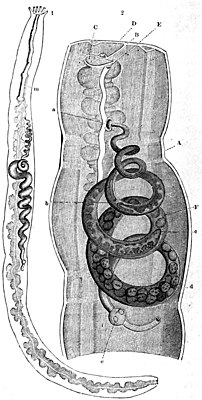Entoconcha mirabilis
| Entoconcha mirabilis | ||||||||||||
|---|---|---|---|---|---|---|---|---|---|---|---|---|

Snail tube ( Entoconcha mirabilis ) in the sea cucumber Oestergrenia digitata . Brehm's Thierleben , 1893 |
||||||||||||
| Systematics | ||||||||||||
|
||||||||||||
| Scientific name of the genus | ||||||||||||
| Entoconcha | ||||||||||||
| J. Müller , 1852 | ||||||||||||
| Scientific name of the species | ||||||||||||
| Entoconcha mirabilis | ||||||||||||
| J. Müller , 1852 |
Entoconcha mirabilis (syn. Helicosyrinx parasita ) is the name of a worm - type from the family of eulimidae , as endoparasite in the body cavity of synaptidae lives. Just as young they can be seen as a worm with house, while the adult, as a worm hose or tube worm called hermaphrodite animal is a long, respectively Schnecklein stuffed with numerous eggs hose. It wasobserved and describedin the 19th century in the Adriatic Sea near Trieste as a parasite of the sea cucumber Oestergrenia digitata .
features
The adult, not recognizable as a snail, has an elongated, cylindrical, irregularly spirally twisted body, on average 2.5 cm long, the head end of which is attached to the blood vessel (dorsal vessel) of the sea cucumber above the intestine . Due to its brownish-yellow color, it is clearly recognizable from the outside through the transparent tissue of an intact worm sea cucumber. The stomach and back are indistinguishable. A snail shell is missing as well as sensory organs, nerves, a heart, a mantle cavity or gills. The mouth is at the button-shaped head end, from which the intestinal canal only takes up about the front third of the body and then ends blindly, with a sac-shaped midgut gland also being present. In the middle section of the body there is the very large ovary with protein glands, which is followed further back by a section for the maturation of the eggs. Behind it is the testicle. Mating and possible self-fertilization have not been investigated, but egg capsules ("brood balls") each with around 20 developing eggs or embryos have been observed in the snail tubes, and Veliger larvae, also called juveniles , in more mature snail tubes. These are released into the host's body cavity through the posterior opening of the body.
The larvae of Entoconcha mirabilis have a spiral shell into which the body can be withdrawn, an operculum , a small sail (velum), two rudimentary antennae, two auditory sacs, a foot and an intestinal canal, and a ciliate cavity. The metamorphosis to the snail tube was just as little observed as the penetration into a new host. The task was never solved, although the Berlin Academy set it as a prize task at the time.
Discovery story
In 1852, Johannes Peter Müller described Entoconcha mirabilis as a microscopic snail that is produced in large numbers in a snail tube in the sea cucumber Synapta digitata . It was not until Albert Otto Baur that 10 years later the snail tube was described as a fully grown stage of the snail and parasite in the sea cucumber and gave it the new name Helicosyrinx parasita . To do this, he had hundreds of sea cucumbers delivered by fishermen in the bay of Muggia before Zaule near Trieste, and he found a snail tube in about every hundredth worm sea cucumber. In 1864 W. Keferstein also decidedly championed the parasitic character of the snail tube as an adult snail stage, but rejected the choice of a new name as a violation of the zoological rules of nomenclature.
literature
- Johannes Müller: About Synapta digitata and the creation of snails in Holothuria. Georg Reimer, Berlin 1852.
- Albert Baur: About Synapta digitata garbage. And their alleged parasites, from April 3, 1862. I. The attachment of the snail tube to the head of the Synapta. II. About the attachment of the snail tube to the intestine. III. The youth forms of the Synapta digitata garbage. Monthly reports of the Royal Prussian Academy of Sciences in Berlin, from the year 1862. Berlin 1863. pp. 187–198 (IS 187–192, II. Pp. 192–193, III. Pp. 193–198).
- Albert Baur: Snail hoses in Synapta. In: J. Henle, W. Keferstein, G. Meissner (eds.): Report on the progress of anatomy and physiology in 1862. Journal for rational medicine. CF Winter, Leipzig / Heidelberg 1864. pp. 191f. ( Digitized version )
- W. Keferstein. Report on the progress of generation theory in 1864. In: J. Henle, W. Keferstein, G. Meissner (Ed.): Report on the progress of anatomy and physiology in 1864. Journal for rational medicine. CF Winter, Leipzig / Heidelberg 1865. Mollusks. Pp. 216-220.
- Albert Baur: Contributions to the natural history of the Synapta digitata, three treatises: Third treatise. The intestinal snail (Helicosyrinx parasita) in the body cavity of the Synapta digitata. E. Blochmann & Sohn, Dresden 1864. Negotiations of the Imperial Leopoldine-Carolinian German Academy of Natural Scientists, Volume 31, pp. 1–119.
- Alfred Brehm : Brehm's Thierleben . General customer of the animal kingdom. Great edition . Volume 10. Bibliographical Institute, Leipzig / Vienna 1893. Holothuria snail tube . Pp. 406-410 .
